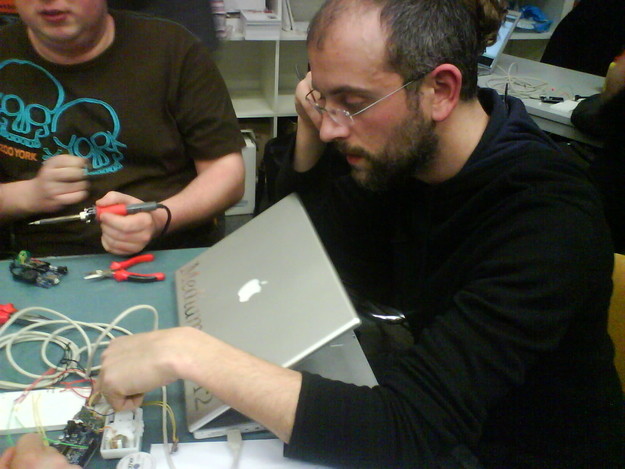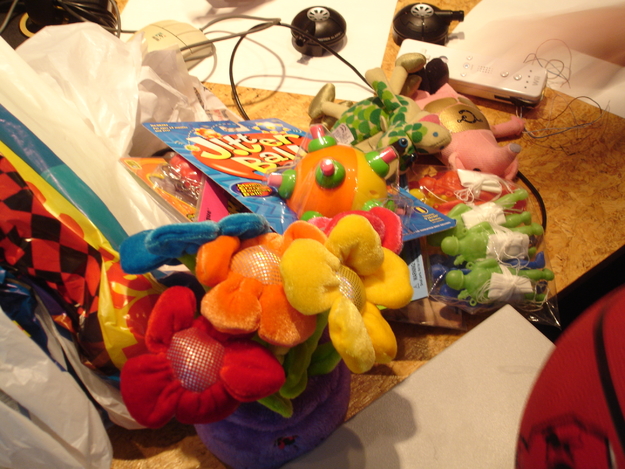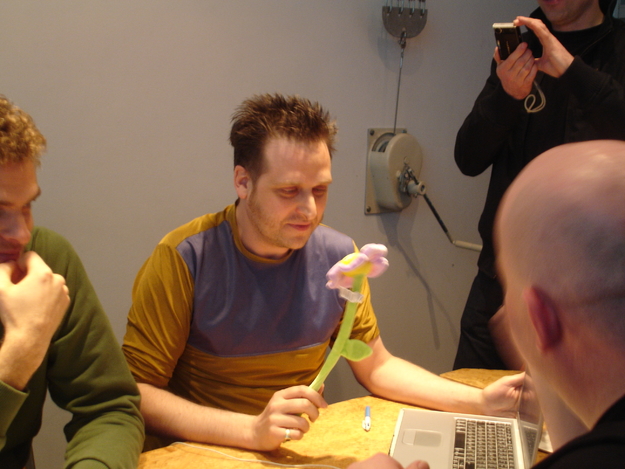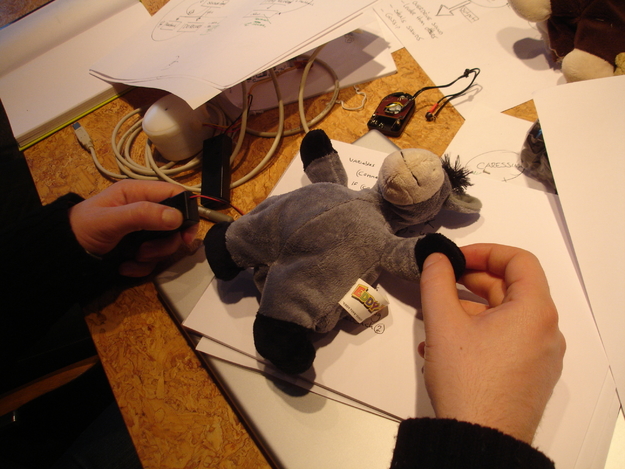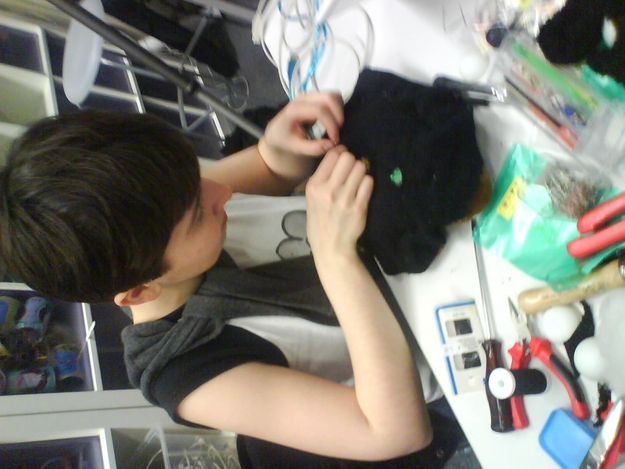Day 1
The participants of the Hybrid Toys workshop trickle into the Mediamatic cafeteria, but it's still early, 9:30. They are at the brink of a new adventure and curiously, but modestly settle in. Loaded with coffee, tea and cookies they head over to the workshop space at 10:00. Klaas Kuitenbrouwer welcomes the group and after a quick introduction round Dana Gordon and Jean-Baptiste Labrune take the floor.
Dana provides a presentation that predominantly can be assessed as thought provoking. Her first act is to rename the Hybrid Toys workshop to "What are good toys?" She suggests we momentarily discard with making value judgments and simply think of toys themselves. Toys, she claims, are the mediators for play. Leaning on ample case studies she provided several qualities of toys; pleasurable, intriguing, evolving, narrative and open. Simplicity, however, is often the key. And everything, even a simple stone, can be turned into a toy!
Jean-Baptiste compliments the presentation to introduce us to the miracle product called "Silly Putty." He shows it as an exemplary toy of the characteristic intrigue. Silly Putty falls in-between liquid and material and is an object of exploration. All participants are given the opportunity to fiddle with the stuff.
As an example of the evolving quality of toys they reminded us of the Tamagotchi toy, with a dynamic interaction. Toys furthermore, they tell, need to be appealing and engaging to the senses. Toys should encourage storytelling.
The presentation made my personal interpretation and definition of toys problematic. You think you know what can be classified as a toy and what can’t, but it turns out, you have no idea! The presentation provoked a "class discussion" on inquiries pertaining the social function and gender attributions of toys. They provide many examples of newly developed toys and a presentation on "reality check" toys (those who prove not as engaging as one may have hoped for) ignited ideas for workshop concepts to follow-up on.
After a short break Auke Touwslager, an information architect provided a presentation on bridging the physical with the virtual. Reformulated, about networked objects. He emphasized that play can be ad-hoc. It can be about surprise and discovery. He provided a couple of fascinating examples: from ways of interfacing information, about overlaying technologies and mash-ups. Auke was primarily interested in questions related to the use of information and how this can be playfully adapted in toys.
Noam wonders why the flower doesn't talk back!
Lunch was there before we knew it. Time to let the material sink in and think long and hard about what toys are, and what ambition one has for the toy. What should it be capable of doing?
The time for listening came to an end and it was the participant's turn to do stuff. The framework had been established and participants where now armed with a little background knowledge and armed with plastic bags filled with toys they had purchased in stores. They were divided into groups and asked to brainstorm about projects they wanted to develop. The whole group consequently discussed these ideas . There was a general tendency to think of the "rules of game" rather than the object of the toy itself.
Dana, JB and Klaas helped to bring the abstract ideas to concrete form. What object is the toy going to be? What material form will it take? The process was above all creative. It was important not to let the technological drive the project, but to reflect on the qualities of toys and see how one would like to develop the objects.
The Mediamatic workshop room became a platform for active creative thought. Whilst one corner of the room I heard ideas of talking oranges, the other was considering social projects from an RFID driven low-budget whisper toy that made going out even more fun.
When the ideas had been brought back to more concrete ideas an inventory was made so that a last minute shopping spree could be realized. Which technologies are needed to realize these ambitions? With the materials ordered, the clock was ticking. Two days left on the calendar. Two days to realize these creative ideas, to make personalized toys.
Day 2
The day started with a fruitful endeavor: the tunneling of the brainstorming and conceptualizing had been done yesterday and now the objective was to fine-tune these. The groups got grip of what they wanted to make. It was time to get down to the nitty gritty! In the groups themselves a technical discussion was taking place in order to get at better grips with the incorporated technologies for the relevant projects. When the chat was over, it was all about making. With Arduino boards, sensors, other technical tools, but also the more everyday materials such as tape, needles and so forth the workshop participants start making their hybrid toys prototype. It is a race against time. A technical 101 is provided in the morning, a quick rundown, but soon it is time for the participants to start MAKING. They did so with the assistance of Tim, Dirk, Klaas and of-course Dana and JB. Time slips away quick and as the night dawns in pizza is ordered and the participants actively and above all enthusiastically work on materializing their ideas. It was magical to see, this act of trial and error. What works in theory after all does not always work in practice. Materials are swapped and ideas are fine-tuned.
Day 3
Everyone arrives just as the clock strikes 10 o'clock. A contrast to the impatience of the first workshop day. Everyone seems tired. The morning is a race against the clock. Dana and JB "threaten" the participants by setting a 12 o’clock deadline for the prototypes. Dana nuanced the tough words by adding a wink. Both Dana and JB knew very well that the deadline they just set would not be met.
The group has split into two areas of production, across two spaces: the workshop room and the atelier. Ironically these places are all but playful, but mandate professionalism. Cables and electronics are ubiquitous. The amount of laptops has quadrupled since day one. Everyone seems to be consumed by getting the right reaction from the toy. Whilst the one group records sounds the other is constantly switching lights off and on to test their light sensors. Another group is working with pressure sensors, yet another with liquid sensors. Collaboration is the motto, a sharing of knowledge and skills is the only way to get the prototypes done.
When lunch arrives the rooms are abandoned. What remains is the image of a workshop battlefield. And indeed there are many casualties. People have been tearing apart and hacking the store toys. They are also actively mending other toys. But these toys have been transformed, and are now capable of so much more. During lunch it is announced that the deadline has been shoved to 2 o'clock. At this time all groups are expected to be able to present their results.
It is two clock. Dirk gives a brief presentation on the computer program “Fritzing.” Fritzing is a tool to help you design PCB's using a virtual breadboard. The tool is also handy for documentation. It is beneficial to everyone over a network, a good way to document.
After Dirk's presentation was THE moment everyone had worked for. The workshop groups had to present their projects. It was an enormously dynamic moment, the closure to three days of hard work. To see the results please surf to the Hybrid toys project page.
Dana and JB concluded the three intense workshop days with these closing thoughts:
Dana
The results are really brilliant and it was very interest to listen and we have interesting topics about design process and trying to mix it with technologies. We did not know what level to expect. The first day was a big confusion when it was more hands-on it changed.
JB
It was interesting to work with you. Struck by the complexity, how simply you get to structures. How very fast the process broke down to simple material, long process. The contraction of time is the most superb of this workshop. It was the major achievement. We remain contactable online. Creativity was in the details. Thank-you!
When the clapping has seized, business cards rapidly exchange hands as many new acquaintances have been made and the sharing from expertise is far from over.
Making Hybrid Toys: Participant reflection
Basically, developing and making toys is about having fun by yourself and the group you are engaged in. If you wanna have the feeling back from your childhood, this workshop is an excellent way to start. By thinking, creating things from scratch and working with different kind of materials and tools, you open up a new world, most of us adults have forgotten about a long time ago.
Hybrid toys is an open invitation to come out and play. After three days of concepting, inventing and realizing at the same time, you’re ready to give up your daily job and become a fulltime toy creator for the rest of your life!
